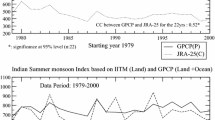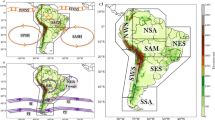Abstract
Using observation and reanalysis data throughout 1961–1990, the East Asian surface air temperature, precipitation and sea level pressure climatology as simulated by seven fully coupled atmosphere-ocean models, namely CCSR/NIES, CGCM2, CSIRO-Mk2, ECHAM4/OPYC3, GFDL-R30, HadCM3, and NCAR-PCM, are systematically evaluated in this study. It is indicated that the above models can successfully reproduce the annual and seasonal surface air temperature and precipitation climatology in East Asia, with relatively good performance for boreal autumn and annual mean. The models’ ability to simulate surface air temperature is more reliable than precipitation. In addition, the models can dependably capture the geographical distribution pattern of annual, boreal winter, spring and autumn sea level pressure in East Asia. In contrast, relatively large simulation errors are displayed when simulated boreal summer sea level pressure is compared with reanalysis data in East Asia. It is revealed that the simulation errors for surface air temperature, precipitation and sea level pressure are generally large over and around the Tibetan Plateau. No individual model is best in every aspect. As a whole, the ECHAM4/OPYC3 and HadCM3 performances are much better, whereas the CGCM2 is relatively poorer in East Asia. Additionally, the seven-model ensemble mean usually shows a relatively high reliability.
Similar content being viewed by others
References
Bueh Cholaw, U. Cubasch, Lin Yonghui, and Ji Liren, 2003: The change of North China climate in transient simulations using the IPCC SRES A2 and B2 scenarios with a coupled atmosphere-ocean general circulation model.Adv. Atmos. Sci.,20, 755–766.
Emori, S., T. Nozawa, A. Abe-Ouchi, A. Numaguti, M. Kimoto, and T. Nakajima, 1999: Coupled ocean atmosphere model experiments of future climate change with an explicit representation of sulphate aerosol scattering.J. Meteor. Soc. Japan,77, 1299–1307.
Flato, G. M., and G. J. Boer, 2001: Warming asymmetry in climate change simulations.Geophys. Res. Lett. 28, 195–198.
Fu Congbin, Wei Helin, Chen Ming, Su Bingkai, Zhao Ming, and Zheng Weizhong, 1998: Simulation of the evolution of summer monsoon rainbelts over eastern China from regional climate model.Chinese J. Atmos. Sci.,22, 522–534. (in Chinese)
Gordon, C., C. Cooper, C. A. Senior, H. T. Banks, J. M. Gregory, T. C. Johns, J. F. B. Mitchell, and R. A. Wood, 2000: The simulation of SST, sea ice extents and ocean heat transports in a version of the Hadley Centre coupled model without flux adjustments.Climate Dyn.,16, 147–168.
Gordon, H. B., and S. P. O′Farrell, 1997: Transient climate change in the CSIRO coupled model with dynamic sea ice.Mon. Wea. Rev.,125, 875–907.
Hu, Z. Z., S. Yang, and R. Wu, 2003: Long-term climate variations in China and global warming signals.J. Geophys. Res.,108 (D19), 4614, doi: 10.1029/2003JD003651.
Hu, Z. Z., L. Bengtsson, and K. Arpe, 2000: Impact of global warming on the Asian winter monsoon in a coupled GCM.J. Geophys. Res.,105 (D4), 4607–4624.
Hulme, M., Zhao Zhongci, and T. Jiang, 1994: Recent and future climate change in East Asia.International Journal of Climatology,14, 637–658.
IPCC, 2001:Climate Change 2001: The Scientific Basis. Contribution of Working Group I to the Third Assessment Report of the Intergovernmental Panel on Climate Change, Houghton et al., eds., Cambridge University Press, Cambridge, United Kingdom and New York, NY, USA, 881pp.
Jiang Dabang, Wang Huijun, and Lang Xianmei, 2004a: East Asian climate change trend under global warming background.Chinese Journal of Geophysics,47, 675–681.
Jiang Dabang, Wang Huijun, and Lang Xianmei, 2004b: Multimodel ensemble prediction for climate change trend of China under SRES A2 scenario.Chinese Journal of Geophysics,47, 878–886.
Kalnay, E., and Coauthors, 1996: The NCEP/NCAR Reanalysis Project.Bull. Amer. Meteor. Soc.,77, 437–472.
Kang, I. -S., and Coauthors, 2002: Intercomparison of the climatological variation of Asian summer monsoon precipitation simulated by 10 GCMs.Climate Dyn.,19, 383–395.
Knutson, T. R., T. L. Delworh, K. W. Dixon, and R. J. Stouffer, 1999: Model assessment of regional surface temperature trends (1949–1997).J. Geophys. Res.,104, 30981–30996.
Nakićenović, N., and Coauthors, 2000:IPCC Special Report on Emissions Scenarios. Cambridge University Press, Cambridge, United Kingdom and New York, NY, USA, 599pp.
New, M., M. Hulme, and P. D. Jones, 1999: Representing twentieth century space-time climate variability. Part I: Development of a 1961–90 mean monthly terrestrial climatology.J. Climate,12, 829–856.
Roeckner, E., J. M. Oberhuber, A. Bacher, M. Christoph, and I. Kirchner, 1996: ENSO variability and atmospheric response in a global coupled atmosphere-ocean GCM.Climate Dyn.,12, 737–754.
Tao Shiyan and Chen Longxun, 1987: A review of recent research on the East Asian monsoon in China.Monsoon Meteorology. Oxford University Press, 60–92.
Washington, W. M., and Coauthors, 2000: Parallel climate model (PCM) control and transient simulations.Climate Dyn.,16, 755–774.
Xu Ying, Ding Yihui, and Zhao Zongci, 2002: Detection and evaluation of effect of human activities on climatic change in East Asia in recent 30 years.Journal of Applied Meteorological Science,13, 513–525. (in Chinese)
Xu Ying, Ding Yihui, Zhao Zongci, and Zhang Jin, 2003a: A scenario of seasonal climate change of the 21st century in Northwest China.Climatic and Environmental Research,8, 19–25. (in Chinese)
Xu Yinlong, Xue Feng, and Lin Yihua, 2003b: Changes of surface air temperature and precipitation in China during the 21st century simulated by HadCM2 under different greenhouse gas emission scenarios.Climatic and Environmental Research,8, 209–217. (in Chinese)
Zeng Qingcun, Zhang Xuehong, and Yuan Chongguang, 1989: Conception, methodology, and actualities of climate model.Advances in Earth Science,4, 1–26. (in Chinese)
Zhao Zongci, and Luo Yong, 1998: Advance on investigations of regional climate modelling since 1990.Acta Meteorologica Sinica,56, 225–246. (in Chinese)
Zhao Zongci, Ding Yihui, Li Xiaodong, and Wang Shaowu, 1995: Evaluation of CGCM climate simulation in East Asian region.Journal of Applied Meteorological Science,6(suppl.), 9–18. (in Chinese)
Zhao Zongci, Ding Yihui, Xu Ying, and Zhang Jin, 2003: Detection and prediction of climate change for the 20th and 21st century due to human activity in North-west China.Climatic and Environmental Research,8, 26–34. (in Chinese)
Author information
Authors and Affiliations
Corresponding author
Rights and permissions
About this article
Cite this article
Dabang, J., Huijun, W. & Xianmei, L. Evaluation of East Asian climatology as simulated by seven coupled models. Adv. Atmos. Sci. 22, 479–495 (2005). https://doi.org/10.1007/BF02918482
Received:
Revised:
Issue Date:
DOI: https://doi.org/10.1007/BF02918482




